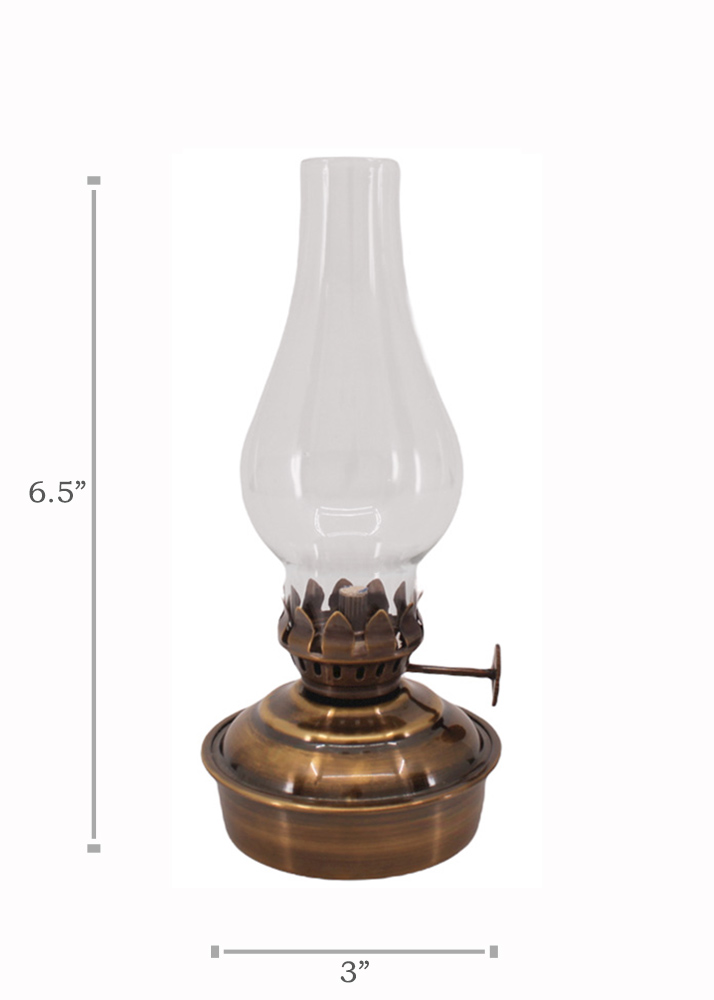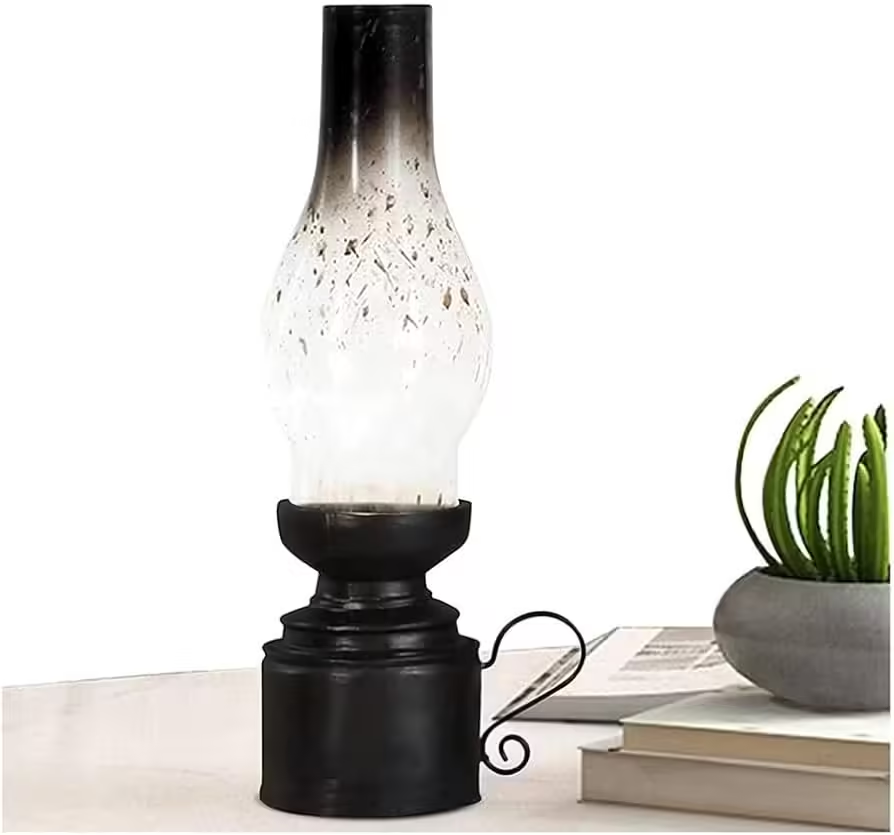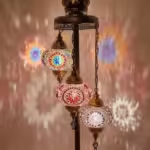An antique oil lamp is a historical lighting device using oil as fuel. These lamps are collectibles and decorative items.
Antique oil lamps hold significant historical value, often dating back to the 19th century. Collectors treasure them for their craftsmanship and intricate designs. Made from materials like brass, glass, and porcelain, these lamps are functional pieces of art. They provide a warm, nostalgic glow, adding charm to any space.
Antique oil lamps come in various styles, including Victorian, Art Nouveau, and early American designs. Proper maintenance, such as cleaning and refilling with appropriate oil, ensures their longevity. Owning an antique oil lamp connects you to history and offers a unique conversation piece for your home.
History Of Oil Lamps
Antique oil lamps have a rich history that spans thousands of years. These lamps have illuminated homes, temples, and streets long before electricity. Understanding the history of oil lamps helps us appreciate their evolution and significance in human civilization.
Origins In Ancient Civilizations
Oil lamps date back to ancient civilizations. These early lamps were simple yet ingenious. They provided light and warmth using oil lamp oil.
In Ancient Egypt, oil lamps were made from pottery. These lamps used wicks for oil lamps to burn animal fat or vegetable oil. Egyptians used these lamps in homes and temples.
In Greece, oil lamps were more refined. They used olive oil as fuel. Greek lamps often had a handle and spout. They were made from clay or bronze.
Rome adopted Greek designs. Roman oil lamps were more decorative. They used paraffin lamp oil. These lamps were common in Roman homes and public baths.
- Egyptians: Pottery lamps, animal fat, vegetable oil
- Greeks: Olive oil, clay, bronze
- Romans: Decorative designs, paraffin lamp oil
In ancient China, oil lamps were called “deng”. They were made from pottery or bronze. These lamps used vegetable oil as fuel. Chinese oil lamps often had intricate designs.
The table below shows the different types of oil used by ancient civilizations:
| Civilization | Type of Oil |
|---|---|
| Egypt | Animal fat, vegetable oil |
| Greece | Olive oil |
| Rome | Paraffin lamp oil |
| China | Vegetable oil |
Evolution Through The Ages
Oil lamps have evolved over centuries. Their designs and materials changed with time. In the Middle Ages, oil lamps became more sophisticated. They used metal and glass. Wicks for oil lamps also improved.
By the 18th century, oil rain lamps were popular. These lamps had intricate designs. They used paraffin lamp oil. The Industrial Revolution brought further changes. Mass production made oil lamps more accessible.
In the 19th century, kerosene lamps became common. Kerosene was cheaper and burned brighter. These lamps had a glass chimney. This design protected the flame from the wind.
- Middle Ages: Metal, glass, improved wicks
- 18th Century: Oil rain lamps, paraffin lamp oil
- 19th Century: Kerosene lamps, glass chimney
By the early 20th century, electric lamps began to replace oil lamps. Yet, antique oil lamps still hold charm. Collectors and enthusiasts appreciate their history and design. Today, many people use oil lamp oil for decorative purposes.
Oil lamp reset is a common practice among collectors. They restore and maintain these antique treasures. This keeps the tradition of oil lamps alive.
Antique oil lamps are more than just light sources. They are pieces of history. Their evolution reflects human innovation and culture.

Credit: www.stlukes.ie
Materials Used
Antique oil lamps have a timeless charm that captivates collectors and history enthusiasts alike. The materials used in these lamps not only define their durability but also their aesthetic appeal. From brass to glass, each material contributes to the lamp’s unique character and functionality.
Common Materials
Antique oil lamps were crafted from a variety of materials, each chosen for its specific properties. Here’s a look at the most common materials used:
- Brass: Brass was a popular choice for its durability and resistance to corrosion. It also provided a bright, reflective surface that enhanced the lamp’s light output.
- Glass: Many antique oil lamps featured glass components, including the chimney and the reservoir. Glass allowed for a clear view of the flame and added an elegant touch.
- Iron: Iron was often used for the lamp’s base and framework. It provided a sturdy foundation and could be intricately designed.
- Porcelain: Porcelain was used for decorative elements and sometimes for the entire lamp body. It was prized for its smooth finish and ability to hold intricate designs.
Each material had its own advantages, making antique oil lamps not only functional but also works of art. For collectors, the material can be a key factor in determining the value and authenticity of a lamp. Whether it’s a vintage lamp with a brass base or a glass reservoir, the material tells a story of its own.
Innovative Designs
Innovation in design has always been a hallmark of antique oil lamps. Each era brought new styles and functionalities. Here are some notable design innovations:
- Adjustable Wicks: The introduction of adjustable wicks allowed users to control the flame size, enhancing the lamp’s versatility.
- Decorative Bases: Bases made from materials like porcelain and brass were often intricately decorated. These designs added a touch of elegance and made each lamp unique.
- Colored Glass: Colored glass chimneys and reservoirs became popular, adding a vibrant aesthetic element. These designs often featured intricate patterns and shapes.
- Heat Lamp Bulb: Some antique designs incorporated early versions of heat lamps. These were used for both lighting and heating purposes.
Modern floor lamps and Turkish lamps often draw inspiration from these antique designs. The use of cordless lamps has also become popular, blending old-world charm with modern convenience. Whether it’s a Christmas story lamp or a lamparas de techo, the influence of antique oil lamp designs can be seen in many contemporary lighting solutions. These innovative designs have ensured that antique oil lamps remain a beloved choice for collectors and decorators alike.
Types Of Antique Oil Lamps
Antique oil lamps have a timeless charm and historical significance. They come in various types, each with unique features and uses. Understanding the different types of antique oil lamps can enrich your appreciation of these beautiful artifacts.
Kerosene Lamps
Kerosene lamps are among the most popular antique oil lamps. They gained widespread use in the 19th century. People preferred them for their bright, steady light and affordability.
Kerosene lamps typically feature:
- A glass chimney to protect the flame
- A wick mechanism to control the flame height
- A fuel reservoir to hold kerosene
These lamps come in various designs, from simple to ornate. Some popular types of kerosene lamps include:
- Hurricane Lamps – Known for their wind-resistant design
- Railroad Lamps – Used historically on trains for signaling
- Table Lamps – Commonly used in homes for everyday lighting
Kerosene lamps were often used alongside other lighting solutions like the uv lamp and gas lamp. Collectors value them for their historical significance and aesthetic appeal. You might find them with intricate lamp finials and decorative glass lamp bodies.
Paraffin Lamps
Paraffin lamps, also known as paraffin wax lamps, became popular in the late 19th and early 20th centuries. They use paraffin oil, a cleaner-burning fuel compared to kerosene.
Paraffin lamps feature:
- A glass chimney similar to kerosene lamps
- A wick trimmer for maintaining the wick
- A stylish base, often made from metal or ceramic
These lamps are known for their bright light and minimal smoke. Many paraffin lamps are collectible items today. They often come with unique designs and decorations. Some popular types include:
- Green Lamps – Known for their distinctive green glass
- Friendship Lamps – Often given as gifts and symbols of friendship
- Decorative Lamps – Featuring intricate patterns and colors
Paraffin lamps, with their lamp lumen myriad, provide a beautiful and nostalgic lighting option. Their lamp lumen myriad resonance beacon is a testament to their enduring charm. Collectors and enthusiasts often seek them for their elegance and historical value.

Credit: www.amazon.com
Collecting Antique Oil Lamps
Antique oil lamps are fascinating relics from the past. Collecting these beautiful pieces is a delightful hobby. Each lamp tells a unique story and adds charm to any collection. Enthusiasts find joy in the hunt for rare lamps and the satisfaction of owning a piece of history. This guide helps collectors find authentic pieces and understand valuation factors.
Finding Authentic Pieces
To find authentic antique oil lamps, research is crucial. Visit antique shops, auctions, and flea markets. Look for distinctive features that signify authenticity:
- Wick Mechanism: Original oil lamps often have a functional wick adjustment mechanism.
- Glass and Metal Quality: Genuine lamps use high-quality glass and metal. Check for wear and patina.
- Manufacturer Marks: Look for stamps or engravings from known manufacturers.
Networking with other collectors also helps. Join online forums and social media groups. Attend antique fairs and exhibitions. Experienced collectors can offer valuable insights and tips.
Maintaining a record of purchases is important. Note the source, price, and any unique characteristics. This helps track the history and authenticity of each lamp.
Consider using a table to record details:
| Source | Price | Unique Characteristics |
|---|---|---|
| Antique Shop | $100 | Brass Base, Hand-Blown Glass |
| Flea Market | $75 | Manufacturer Stamp, Patina |
Valuation Factors
Several factors determine the value of antique oil lamps. Understanding these helps in making informed decisions.
Age is a primary factor. Older lamps are generally more valuable. Condition is equally important. Lamps in good condition fetch higher prices. Look for cracks, chips, or missing parts.
Rarity significantly affects value. Rare models or limited editions are highly sought after. Provenance also plays a role. Lamps with a well-documented history are more desirable.
Consider the following factors for valuation:
- Age: Older lamps, especially those from the 19th century, are more valuable.
- Condition: Lamps without damage or repairs are worth more.
- Rarity: Unique designs or limited production models are prized.
- Provenance: Documented history adds to the lamp’s value.
Market trends also influence value. Keeping an eye on auction results and antique market trends helps. Prices can vary based on demand and availability.
By understanding these factors, collectors can make better purchasing decisions. This ensures their collection remains valuable and historically significant.
Restoration Techniques
Antique oil lamps exude charm and timeless elegance. Restoring these treasures not only preserves their beauty but also ensures they function properly. Explore effective restoration techniques to breathe new life into these vintage pieces.
Cleaning Methods
Cleaning an antique oil lamp requires care and attention. Start by disassembling the lamp, ensuring you keep track of all parts. Use a soft, damp cloth to wipe off dust and grime from the glass lamps and metal components.
For stubborn dirt, a mixture of mild soap and warm water works wonders. Avoid using abrasive cleaners or sponges as they can scratch the surface. Instead, opt for a soft-bristled brush to gently scrub intricate details.
Here’s a simple cleaning method:
- Remove soot: Soak the glass chimney in warm soapy water.
- Polish metal: Use a mixture of vinegar and baking soda for brass parts.
- Dry thoroughly: Ensure all parts are completely dry before reassembling.
For delicate parts, such as the burner, use a cotton swab dipped in alcohol to clean crevices. Regular maintenance, similar to what you’d do with end table lamps or floor lamps for reading, keeps the lamp in top condition.
Repairing Components
Repairing an antique oil lamp involves fixing or replacing damaged parts. Start by inspecting the lamp thoroughly. Look for cracks in the glass, worn-out wicks, or broken metal components.
Common repairs include:
- Replacing wicks: Purchase new wicks compatible with your lamp model.
- Fixing glass: Use epoxy to repair small cracks or replace broken glass parts.
- Metal repairs: Solder or replace damaged metal components.
If the lamp has rust, use a rust remover or a mixture of lemon juice and salt. Apply the solution with a cloth and scrub gently. For flower floor lamps or glass lamps, handle with extra care to avoid further damage.
Here’s a quick guide to repair:
| Component | Repair Method |
|---|---|
| Wick | Replace with a new wick |
| Glass | Use epoxy or replace |
| Metal | Solder or replace |
Ensure all repairs are done with precision. A well-maintained lamp adds character to your home, just like a giant lava lamp or lamp posts outdoor.

Credit: www.vermontlanterns.com
Display And Decor
Antique oil lamps add a unique charm to any space. These timeless pieces offer a glimpse into the past while enhancing the aesthetic of your home. Displaying and decorating with these lamps can transform your living spaces, making them more inviting and elegant.
Best Practices For Showcasing
Showcasing antique oil lamps requires thoughtful consideration to highlight their beauty. Here are some best practices to help you:
- Choose the Right Spot: Place the lamp in a prominent position where it can be appreciated. Consider areas like mantelpieces, side tables, or as a centerpiece on a dining table.
- Proper Lighting: Use soft, warm lighting to enhance the lamp’s features. Avoid harsh lights that can overshadow its delicate details.
- Complementary Decor: Surround the lamp with items that match its vintage style. Think about pairing it with antique vases, picture frames, or vintage books.
Creating a display that features these lamps can be enhanced by using a table:
| Display Area | Complementary Items |
|---|---|
| Mantelpiece | Vintage vases, framed photos, old clocks |
| Side Table | Antique books, small sculptures, candles |
| Dining Table | Floral centerpieces, classic tableware, lace doilies |
Antique oil lamps like the Aladdin lamp or A Christmas Story lamp should be the focal point. Ensure they are clean and polished. Dust and grime can detract from their beauty. Consider using a Bills lamp repair service to keep them in pristine condition.
Integrating In Modern Spaces
Integrating antique oil lamps into modern spaces can create a striking contrast. Here are some tips to do this effectively:
- Mix and Match: Combine the lamp with modern furniture. A boho floor lamp or a black lamp can complement the antique style.
- Minimalist Approach: Keep the surrounding decor simple. This allows the lamp to stand out without competing with other items.
- Functional Decor: Use the lamp as both a decorative piece and a functional one. An end table with lamp can serve dual purposes.
Here is how you can integrate these lamps into various modern spaces:
| Modern Space | Integration Tips |
|---|---|
| Living Room | Pair with a sleek, modern sofa and a vintage floor lamp. |
| Bedroom | Place on a minimalist bedside table. Use soft, ambient lighting. |
| Office | Place on a contemporary desk. Combine with modern desk accessories. |
To make the lamp pop, consider using contrasting colors. For example, a dark, moody room can highlight the lamp’s intricate details. Antique floor lamps can add height and drama to any space. Unique lamps can serve as conversation starters. They can also be a tribute to the past while fitting seamlessly into modern decor.
Safety Considerations
Antique oil lamps bring a touch of vintage charm and elegance to any space. However, it’s essential to consider safety measures while using and storing these lamps. Proper safety considerations ensure that you enjoy the beauty of antique oil lamps without any hazards.
Using Oil Lamps Safely
Using antique oil lamps safely is crucial to prevent accidents. Here are some essential tips to keep in mind:
- Keep lamps on stable surfaces: Place oil lamps on flat, stable surfaces to avoid tipping over.
- Maintain a safe distance: Keep lamps away from flammable materials like curtains, paper, and furniture.
- Never leave unattended: Do not leave oil lamps burning when you leave the room or go to sleep.
- Use proper oil: Use lamp oil specifically designed for oil lamps. Avoid using gasoline or other flammable liquids.
- Ensure proper ventilation: Use oil lamps in well-ventilated areas to prevent the buildup of harmful fumes.
It’s also important to conduct regular maintenance checks. Ensure the wick is trimmed to the right length and replace it if necessary. Clean the lamp’s chimney to prevent soot buildup, which can hinder the flame and cause smoke.
| Do’s | Don’ts |
|---|---|
| Use lamp oil | Use gasoline |
| Place on stable surfaces | Place near flammable items |
| Trim the wick | Leave unattended |
Storage Guidelines
Proper storage of antique oil lamps ensures their longevity and safety. Follow these guidelines:
- Empty the oil: Before storing, empty any remaining oil to prevent leaks and spills.
- Clean thoroughly: Clean the lamp, including the chimney and wick holder, to remove any residue.
- Store in a cool, dry place: Keep the lamp in a cool, dry place away from direct sunlight and extreme temperatures.
- Use protective covers: Cover the lamp with a cloth or use a storage box to protect it from dust and damage.
- Check periodically: Periodically check the stored lamp for any signs of damage or deterioration.
Storing oil lamps properly helps maintain their condition and ensures they are ready for safe use when needed. Keep them away from children’s reach to prevent accidental misuse. By following these guidelines, you can enjoy your antique oil lamps for many years to come.
Famous Antique Oil Lamps
Antique oil lamps have a charm that modern lighting can’t replicate. They carry history, craftsmanship, and timeless beauty. Famous antique oil lamps are prized by collectors and history enthusiasts. Each lamp tells a story and adds a unique touch to any home decor.
Notable Brands
Several brands stand out in the world of antique oil lamps. These lamps are known for their quality, design, and historical value. Collectors often seek specific brands due to their reputation and rarity.
- Aladdin: Aladdin lamps are renowned for their craftsmanship and durability. Founded in 1908, Aladdin introduced the mantle lamp, which provided brighter light.
- Rayo: Rayo lamps, made by Bradley & Hubbard, are famous for their intricate designs. These lamps were popular in the late 19th and early 20th centuries.
- Rochester: Rochester lamps are another sought-after brand. Known for their ornate details, these lamps were produced by the Rochester Lamp Company.
Other notable brands include:
| Brand | Key Feature |
|---|---|
| Dietz | Durable and practical design |
| Queen Anne | Elegant and decorative |
| Blue Flame | Bright and efficient light |
These brands have left a lasting impact on the history of lighting. They are often compared to modern lighting options like the solar street lamp or the tree floor lamp for their innovation and design.
Historical Significance
Antique oil lamps hold significant historical value. They represent the evolution of lighting before electricity became widespread. These lamps lit homes, streets, and public spaces.
During the 19th century, oil lamps were a primary source of light. The invention of the kerosene lamp in the 1850s revolutionized lighting. It made lamps more efficient and accessible.
- Victorian Era: Oil lamps from this period are highly decorative. They often feature intricate designs and colorful glass.
- Pioneer Days: Simple and functional, these lamps were essential for daily life in rural areas.
- Industrial Revolution: Mass production made oil lamps more affordable. This allowed wider use in homes and businesses.
Oil lamps also played a role in cultural and social events. They were used in theaters, churches, and celebrations. Today, they are treasured by collectors for their beauty and history. Their design inspires modern unique table lamps, uttermost lamps, and even novelty items like the spiderman lamp and stitch lamp.
Antique oil lamps connect us to the past. They remind us of a time when light was precious and craftsmanship was valued.
Frequently Asked Questions
How Do I Know If My Oil Lamp Is Valuable?
Check for makers’ marks, age, and condition. Research similar items online. Consult an antiques expert for appraisal.
Are Old Oil Lamps Valuable?
Yes, old oil lamps can be valuable. Their worth depends on age, rarity, condition, and craftsmanship. Collectors often seek unique pieces.
At What Age Are Oil Lamps Considered Antique?
Oil lamps are considered antique if they are over 100 years old. Collectors often seek lamps from the 19th century.
Are Antique Lamps Worth Anything?
Antique lamps can be valuable, especially if they are rare or in excellent condition. Their worth depends on age, maker, and design. Collectors often seek unique pieces, increasing their market value. Always consult a professional appraiser for an accurate valuation.
Conclusion
Antique oil lamps offer a timeless charm and practical utility. They add a touch of history to any space. Whether for decoration or use, these lamps make a unique statement. Embrace the elegance and functionality of antique oil lamps in your home today.



